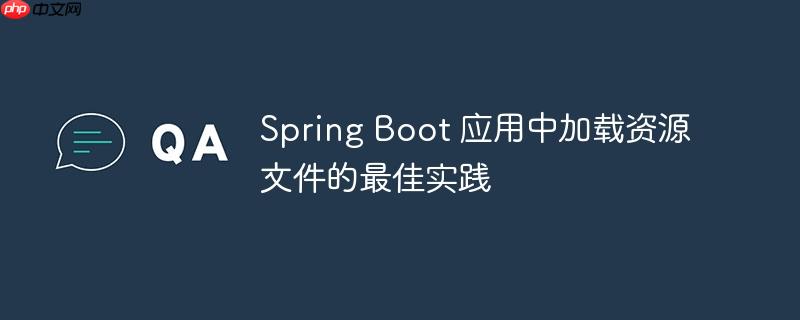
本文旨在探讨spring Boot应用中资源文件加载的最佳实践,尤其针对将应用打包为JAR后传统方式失效的问题。我们将详细介绍如何利用Spring Framework提供的ClassPathResource和FileCopyUtils工具类,以稳定可靠的方式读取src/main/resources目录下的各类文件,确保开发与生产环境的一致性,避免资源加载异常。
在spring boot应用程序开发中,我们通常将配置文件、模板、密钥文件等资源放置在src/main/resources目录下。在开发阶段,这些文件通常直接位于文件系统上,因此使用Java.nio.file.paths或classloader.getsystemresource等标准java api来加载它们通常没有问题。然而,当spring boot应用被打包成一个可执行的jar文件时,这些资源不再是独立的文件,而是作为jar包内部的条目存在。此时,基于文件系统路径的传统加载方式将失效,导致filenotfoundexception或filesystemnotfoundexception等运行时错误。
为了解决这一问题,Spring Framework提供了一套强大且灵活的资源加载机制,其中org.springframework.core.io.ClassPathResource是处理类路径资源的理想选择。它能够透明地处理资源位于文件系统、JAR包内部或URL的情况,确保在不同部署环境下的一致性。
使用 ClassPathResource 加载资源文件
以下是一个通用的工具方法,它利用ClassPathResource来读取指定路径的资源文件内容:
import org.springframework.core.io.ClassPathResource; import org.springframework.util.FileCopyUtils; import java.io.IOException; import java.util.Objects; import org.slf4j.Logger; import org.slf4j.LoggerFactory; /** * 资源加载工具类 */ public class ResourceLoaderUtil { private static final Logger log = LoggerFactory.getLogger(ResourceLoaderUtil.class); /** * 从类路径加载资源文件内容并返回字符串 * * @param resourcePath 资源在类路径中的相对路径,例如 "key/private.pem" * @return 资源文件的内容字符串,如果加载失败则返回NULL */ public static String getResourceFileContent(String resourcePath) { Objects.requireNonNull(resourcePath, "Resource path cannot be null."); ClassPathResource resource = new ClassPathResource(resourcePath); try { // 获取资源的InputStream并使用FileCopyUtils读取为字节数组 byte[] bytes = FileCopyUtils.copyToByteArray(resource.getInputStream()); return new String(bytes); } catch(IOException ex) { log.error("Failed to load resource file: {}", resourcePath, ex); return null; // 在实际应用中,可能需要抛出自定义异常 } } }
代码解析:
- ClassPathResource resource = new ClassPathResource(resourcePath);:ClassPathResource的构造函数接受一个字符串参数,该参数是资源在类路径中的相对路径。例如,如果你的文件在src/main/resources/key/private.pem,那么路径就是”key/private.pem”。
- resource.getInputStream():此方法返回一个InputStream,无论资源是在文件系统上还是在JAR包内部,它都能提供对资源内容的访问。
- FileCopyUtils.copyToByteArray(resource.getInputStream()):FileCopyUtils是spring框架提供的一个实用工具类,它能高效地将InputStream中的所有字节读取到一个byte[]数组中。这比手动循环读取流更简洁和高效。
- new String(bytes):将字节数组转换为字符串,通常适用于文本文件。如果处理二进制文件,则直接使用byte[]。
密钥文件加载示例
现在,我们将上述工具方法集成到加载公钥和私钥的场景中。假设你的密钥文件public.pem和private.pem位于src/main/resources/key/目录下。
import java.security.KeyFactory; import java.security.NoSuchAlgorithmException; import java.security.PrivateKey; import java.security.PublicKey; import java.security.spec.InvalidKeySpecException; import java.security.spec.PKCS8EncodedKeySpec; import java.security.spec.X509EncodedKeySpec; import java.util.Base64; public class KeyService { // 假设 ResourceLoaderUtil 类在同一个项目中可访问 /** * 获取公钥文件的内容 * @return 公钥字符串 */ private String getPublicKeyContent() { // 使用 ResourceLoaderUtil 加载公钥文件 return ResourceLoaderUtil.getResourceFileContent("key/public.pem"); } /** * 获取私钥文件的内容 * @return 私钥字符串 */ private String getPrivateKeyContent() { // 使用 ResourceLoaderUtil 加载私钥文件 return ResourceLoaderUtil.getResourceFileContent("key/private.pem"); } /** * 根据内容生成 PublicKey 对象 * @return PublicKey 对象 * @throws NoSuchAlgorithmException 如果算法不支持 * @throws InvalidKeySpecException 如果密钥规范无效 */ public PublicKey getPublicKey() throws NoSuchAlgorithmException, InvalidKeySpecException { String keyContent = getPublicKeyContent(); if (keyContent == null) { throw new IllegalStateException("Public key content could not be loaded."); } // 清理密钥字符串,移除头部、尾部和换行符 String key = keyContent.replaceAll("n", "") .replace("-----BEGIN PUBLIC KEY-----", "") .replace("-----END PUBLIC KEY-----", ""); X509EncodedKeySpec keySpec = new X509EncodedKeySpec(Base64.getDecoder().decode(key)); KeyFactory kf = KeyFactory.getInstance("RSA"); return kf.generatePublic(keySpec); } /** * 根据内容生成 PrivateKey 对象 * @return PrivateKey 对象 * @throws NoSuchAlgorithmException 如果算法不支持 * @throws InvalidKeySpecException 如果密钥规范无效 */ public PrivateKey getPrivateKey() throws NoSuchAlgorithmException, InvalidKeySpecException { String keyContent = getPrivateKeyContent(); if (keyContent == null) { throw new IllegalStateException("Private key content could not be loaded."); } // 清理密钥字符串,移除头部、尾部和换行符 String key = keyContent.replaceAll("n", "") .replace("-----BEGIN PRIVATE KEY-----", "") .replace("-----END PRIVATE KEY-----", ""); PKCS8EncodedKeySpec keySpec = new PKCS8EncodedKeySpec(Base64.getDecoder().decode(key)); KeyFactory kf = KeyFactory.getInstance("RSA"); return kf.generatePrivate(keySpec); } }
通过这种方式,无论你的Spring Boot应用是作为普通Java应用运行,还是打包成JAR文件部署,ResourceLoaderUtil都能可靠地找到并加载src/main/resources目录下的资源文件。
注意事项与最佳实践
- 资源路径的准确性: ClassPathResource接受的路径是相对于类路径根目录的。例如,如果文件在src/main/resources/config/app.properties,则路径应为”config/app.properties”。
- 错误处理: 在实际应用中,资源加载失败(例如文件不存在或IO错误)时,不应简单返回null。更推荐的做法是抛出特定的运行时异常(如ResourceNotFoundException或ResourceLoadingException),以便调用方能够捕获并进行适当的处理,例如日志记录、回退机制或向用户提示错误。
- Spring ResourceLoader 接口: 对于更高级或更通用的资源加载需求,Spring提供了org.springframework.core.io.ResourceLoader接口。它提供了一个统一的getResource(String location)方法,可以根据location前缀(如classpath:, file:, http:)加载不同类型的资源。Spring Boot的ApplicationContext本身就实现了ResourceLoader接口,因此你可以直接注入ResourceLoader来获取资源。
- 敏感信息管理: 尽管本教程展示了如何从JAR内部加载密钥,但在生产环境中,将敏感信息(如私钥)直接打包在应用程序JAR中并非最佳实践。更安全的做法是将它们存储在外部安全配置中,例如:
- 环境变量
- spring cloud Config Server
- HashiCorp Vault 或 AWS Secrets Manager 等密钥管理服务
- 安全的外部文件系统路径(通过file:前缀加载)
总结
在Spring Boot应用中,为了确保资源文件在开发和生产环境(尤其是JAR包部署)下都能被正确加载,应优先使用Spring Framework提供的ClassPathResource。它提供了一种统一且健壮的机制来访问类路径中的资源。通过封装成通用的工具方法,可以提高代码的可重用性和可维护性。同时,对于敏感信息,务必遵循安全最佳实践,避免将其硬编码或直接打包在应用程序中。



















